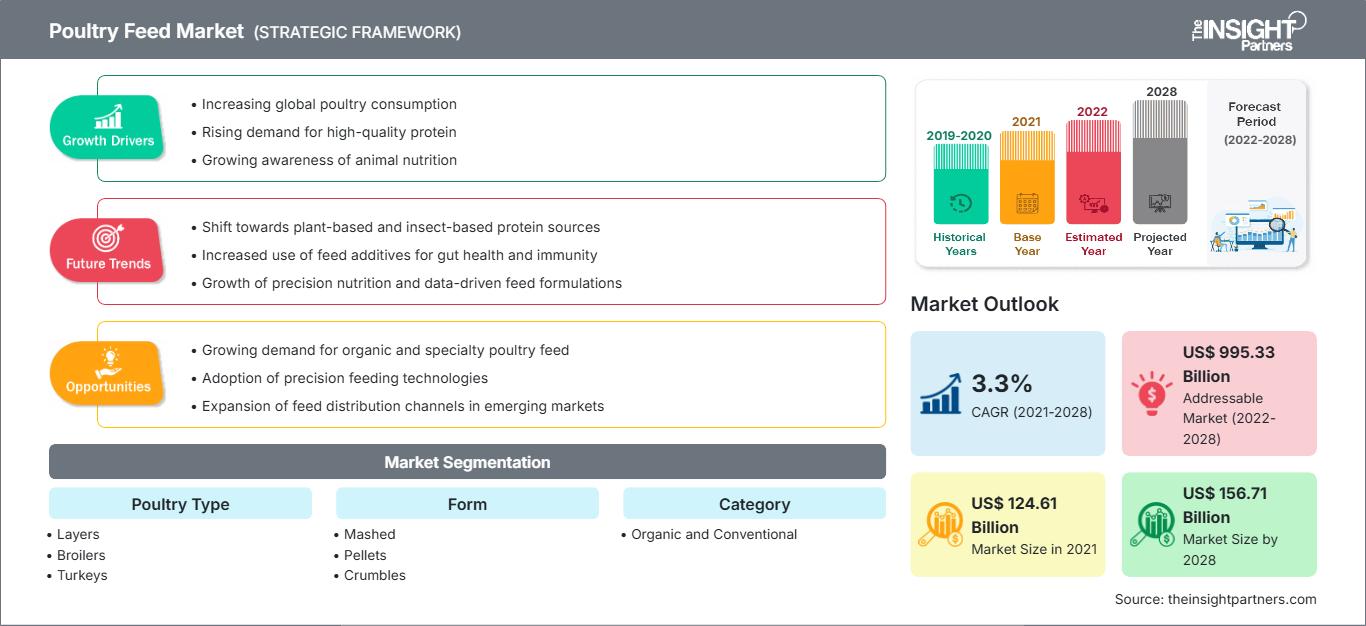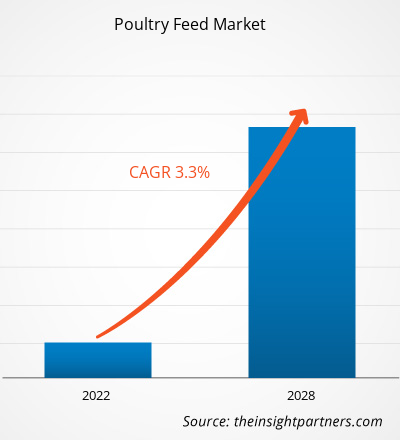Der Markt für Geflügelfutter wurde im Jahr 2021 auf 124.611 Millionen US-Dollar geschätzt und soll bis 2028 156.710 Millionen US-Dollar erreichen; von 2021 bis 2028 wird ein durchschnittliches jährliches Wachstum von 3,3 % erwartet.
Geflügelfutter wird aus verschiedenen Rohstoffen wie Getreide und Körnern, Kuchen oder Ölmehl sowie Futterzusätzen hergestellt. Der Nährstoffbedarf des Geflügelfutters hängt vom Gewicht und Alter des Geflügels, seiner Wachstumsrate und der Eierproduktion ab. Der steigende Konsum von Geflügelprodukten belebt den Geflügelfuttermarkt. Im Jahr 2020 hatte der asiatisch-pazifische Raum den größten Umsatzanteil am globalen Geflügelfuttermarkt. Mit einer großen Basis an Geflügelfleisch konsumierender Bevölkerung verzeichnet der asiatisch-pazifische Geflügelfuttermarkt ein bemerkenswertes Wachstum und wird dies voraussichtlich in den nächsten Jahren fortsetzen. China und Indien sind die beiden weltweit führenden Geflügelfutterproduzenten. In Indien zählt die Geflügelfutterindustrie zu den am schnellsten wachsenden Branchen, wobei der Wettbewerb zwischen den Futtermittelherstellern zunimmt. Verbraucher in dieser Region suchen nach zusätzlichen Quellen für proteinreiche Lebensmittel. Die steigende Nachfrage nach proteinreichen Lebensmitteln, gepaart mit einer gestiegenen Kaufkraft, hat den Geflügelfleischkonsum stark angekurbelt. All diese Faktoren dürften das Wachstum des Geflügelfuttermarktes im asiatisch-pazifischen Raum im Prognosezeitraum befeuern.
Passen Sie diesen Bericht Ihren Anforderungen an
Sie erhalten kostenlos Anpassungen an jedem Bericht, einschließlich Teilen dieses Berichts oder einer Analyse auf Länderebene, eines Excel-Datenpakets sowie tolle Angebote und Rabatte für Start-ups und Universitäten.
Geflügelfuttermarkt: Strategische Einblicke

- Holen Sie sich die wichtigsten Markttrends aus diesem Bericht.Dieses KOSTENLOSE Beispiel umfasst Datenanalysen, die von Markttrends bis hin zu Schätzungen und Prognosen reichen.
Auswirkungen der COVID-19-Pandemie auf den Geflügelfuttermarkt
Sie erhalten kostenlos Anpassungen an jedem Bericht, einschließlich Teilen dieses Berichts oder einer Analyse auf Länderebene, eines Excel-Datenpakets sowie tolle Angebote und Rabatte für Start-ups und Universitäten.
Geflügelfuttermarkt: Strategische Einblicke

- Holen Sie sich die wichtigsten Markttrends aus diesem Bericht.Dieses KOSTENLOSE Beispiel umfasst Datenanalysen, die von Markttrends bis hin zu Schätzungen und Prognosen reichen.
Die anhaltende COVID-19-Pandemie machte präventive Maßnahmen erforderlich, die die Situation der Tierfutterindustrie drastisch veränderten und das Wachstum des Geflügelfuttermarktes negativ beeinflussten. Regierungen weltweit ordneten die Schließung ihrer internationalen Häfen an, was zu weiteren Störungen in der Geflügelfutter-Lieferkette führte. Die COVID-19-Pandemie beeinträchtigte die Verfügbarkeit von Rohstoffen zur Herstellung von Geflügelfutter in fast allen Ländern. Mais und Sojabohnen sind die Hauptzutaten von Geflügelfutter. Viele Länder weltweit, die auf Importe dieser Rohstoffe zur Herstellung von Geflügelfutter angewiesen sind, hatten erhebliche Probleme bei der Beschaffung der Zutaten. Die Verfügbarkeit von Geflügelfutter war aufgrund der Schließung von Futtermittelfabriken vielerorts eingeschränkt. Der weltweite Konsum von Geflügelfleisch ging drastisch zurück. Die Geflügelfutterindustrie wurde durch die Schließung von Restaurants weltweit stark getroffen. Da die Volkswirtschaften jedoch planen, ihre Betriebe wieder anzukurbeln, wird erwartet, dass die Nachfrage nach Geflügelfutter weltweit steigt. Die steigende Nachfrage nach Geflügelfutter und erhebliche Investitionen namhafter Hersteller dürften das Wachstum des Geflügelfuttermarktes vorantreiben.
Markteinblicke
Wachsende Geflügelproduktion
Treibt Wachstum des Geflügelfuttermarktes an
Der Geflügelsektor verzeichnet weltweit ein kontinuierliches Wachstum. Geflügel gilt als eine der kostengünstigsten Proteinquellen, weshalb die Nachfrage nach Geflügelprodukten wie Eiern und Fleisch weiter steigt. Der Hühnerfleischkonsum steigt stark unter gesundheitsbewussten Menschen. Der Aufschwung in der Geflügelproduktion deckt in hohem Maße den steigenden Bedarf der Weltbevölkerung. Laut der Ernährungs- und Landwirtschaftsorganisation der USA (FAO) ist die weltweite Geflügelfleischproduktion zwischen 1961 und 2019 von 9 auf 132 Millionen Tonnen gestiegen, die Eierproduktion von 15 auf 90 Millionen Tonnen. Die stark steigende Geflügelproduktion erfordert den Einsatz hochwertiger Geflügelfutterprodukte.
Einblicke in Geflügelarten
Basierend auf der Geflügelart ist der globale Markt für Geflügelfutter in Legehennen, Masthähnchen, Truthähne und sonstige Geflügelarten unterteilt. Das Masthähnchensegment hatte 2020 den größten Marktanteil. Masthähnchen sind Hühner, die zur Fleischproduktion gezüchtet werden und mit einer proteinreichen Ernährung gefüttert werden, um ein schnelles Wachstum zu unterstützen. Masthähnchenfutter gibt es in verschiedenen Formen, z. B. als Brei, Pellets und Krümelfutter. Indien ist einer der größten Masthähnchenproduzenten, und die Nachfrage nach Mischfutter in der Masthähnchenindustrie steigt. Die steigende Masthähnchenproduktion wird die Nachfrage nach Masthähnchenfutter im Prognosezeitraum weiter ankurbeln.
Einblicke in die Form
Basierend auf der Form ist der globale Markt für Geflügelfutter in Brei, Pellets, Krümelfutter und sonstige Geflügelfutter unterteilt. Das Segment Pellets hatte 2020 den größten Marktanteil. Pelletfutter wird durch die Verwendung von Dampf und Druck zur Komprimierung von Maischefutter hergestellt. Maischefutter wird in einer Pelletmühle komprimiert und zu harten, trockenen Pellets geformt. Das Pelletfutter verbessert die Wachstumsrate von Masthähnchen durch eine erhöhte Futteraufnahme. Dies ist auf eine bessere Verdaulichkeit, eine geringere Trennung der Inhaltsstoffe und eine höhere Schmackhaftigkeit zurückzuführen. Da die Inhaltsstoffe in jedem Pellet gut vermischt sind, gewährleistet Pelletfutter eine ausgewogene Ernährung, eine bessere Futterverwertung und Leistung bei Geflügel. Die Vorteile von Pelletfutter, wie z. B. leicht verdauliches Futter, eine ausgewogene Ernährung und weniger Abfall, tragen in der Regel zu seiner hohen Nachfrage bei.
Einige wichtige Akteure auf dem globalen Geflügelfuttermarkt sind ADM; Cargill, Incorporated.; Alltech.; Charoen Pokphand Foods PCL; For Farmers; Kent Corporation; SHV Holdings; Land O'Lakes, Inc.; AFGRI Animal Feeds; und DE HEUS ANIMAL NUTRITION. Die auf dem Markt tätigen Akteure konzentrieren sich stark auf die Entwicklung qualitativ hochwertiger und innovativer Produktangebote, um die Anforderungen der Kunden zu erfüllen.
Markt für Geflügelfutter
Die Analysten von The Insight Partners haben die regionalen Trends und Faktoren, die den Geflügelfuttermarkt im Prognosezeitraum beeinflussen, ausführlich erläutert. In diesem Abschnitt werden auch die Marktsegmente und die geografische Lage in Nordamerika, Europa, dem asiatisch-pazifischen Raum, dem Nahen Osten und Afrika sowie Süd- und Mittelamerika erörtert.Umfang des Marktberichts für Geflügelfutter
| Berichtsattribut | Einzelheiten |
|---|---|
| Marktgröße in 2021 | US$ 124.61 Billion |
| Marktgröße nach 2028 | US$ 156.71 Billion |
| Globale CAGR (2021 - 2028) | 3.3% |
| Historische Daten | 2019-2020 |
| Prognosezeitraum | 2022-2028 |
| Abgedeckte Segmente |
By Geflügelart
|
| Abgedeckte Regionen und Länder | Nordamerika
|
| Marktführer und wichtige Unternehmensprofile |
|
Dichte der Marktteilnehmer für Geflügelfutter: Verständnis ihrer Auswirkungen auf die Geschäftsdynamik
Der Markt für Geflügelfutter wächst rasant. Die steigende Nachfrage der Endverbraucher ist auf Faktoren wie veränderte Verbraucherpräferenzen, technologische Fortschritte und ein stärkeres Bewusstsein für die Produktvorteile zurückzuführen. Mit der steigenden Nachfrage erweitern Unternehmen ihr Angebot, entwickeln Innovationen, um den Bedürfnissen der Verbraucher gerecht zu werden, und nutzen neue Trends, was das Marktwachstum weiter ankurbelt.
- Holen Sie sich die Geflügelfuttermarkt Übersicht der wichtigsten Akteure
Bericht-Spotlights
- Fortschreitende Branchentrends im Geflügelfuttermarkt, um den Akteuren bei der Entwicklung effektiver langfristiger Strategien zu helfen
- Geschäftswachstumsstrategien in entwickelten und sich entwickelnden Märkten
- Quantitative Analyse des Geflügelfuttermarktes von 2019 bis 2028
- Schätzung der weltweiten Nachfrage nach Geflügelfutter
- Porters Fünf-Kräfte-Analyse zur Veranschaulichung der Wirksamkeit von Käufern und Lieferanten in der Branche
- Jüngste Entwicklungen zum Verständnis des wettbewerbsorientierten Marktszenarios
- Markttrends und -aussichten sowie Faktoren, die das Wachstum des Geflügelfuttermarktes vorantreiben und hemmen
- Unterstützung im Entscheidungsprozess durch Hervorhebung von Marktstrategien, die das kommerzielle Interesse untermauern und zum Marktwachstum führen
- Die Größe des Geflügelfuttermarktes an verschiedenen Knotenpunkten
- Detaillierte Übersicht und Segmentierung des Markt sowie die Dynamik der Geflügelfutterindustrie
- Größe des Geflügelfuttermarktes in verschiedenen Regionen mit vielversprechenden Wachstumschancen
Globaler Geflügelfuttermarkt
Nach Geflügelart
- Legehennen
- Broiler
- Puten
- Sonstige
Nach Form
- Püree
- Pellets
- Krümel
- Sonstige
Nach Kategorie
- Bio
- Konventionell
Firmenprofile
- ADM
- Cargill, Incorporated.
- Alltech.
- Charoen Pokphand Foods PCL
- ForFarmers
- Kent Corporation
- SHV Holdings
- Land O'Lakes, Inc.
- AFGRI Animal Feeds
- DE HEUS ANIMAL NUTRITION
- Historische Analyse (2 Jahre), Basisjahr, Prognose (7 Jahre) mit CAGR
- PEST- und SWOT-Analyse
- Marktgröße Wert/Volumen – Global, Regional, Land
- Branchen- und Wettbewerbslandschaft
- Excel-Datensatz
Aktuelle Berichte
Verwandte Berichte
Erfahrungsberichte
Grund zum Kauf
- Fundierte Entscheidungsfindung
- Marktdynamik verstehen
- Wettbewerbsanalyse
- Kundeneinblicke
- Marktprognosen
- Risikominimierung
- Strategische Planung
- Investitionsbegründung
- Identifizierung neuer Märkte
- Verbesserung von Marketingstrategien
- Steigerung der Betriebseffizienz
- Anpassung an regulatorische Trends




















 Kostenlose Probe anfordern für - Geflügelfuttermarkt
Kostenlose Probe anfordern für - Geflügelfuttermarkt